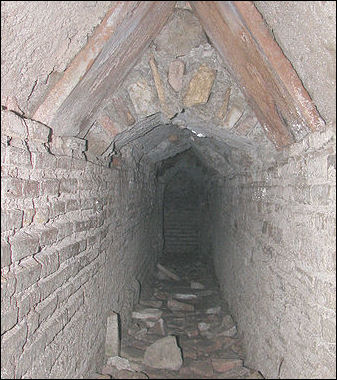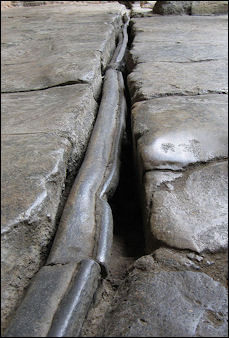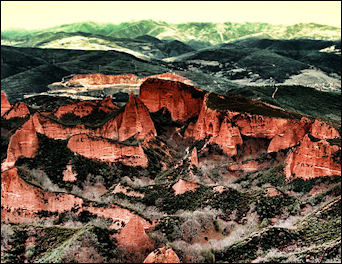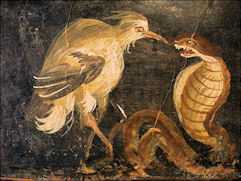Home | Category: Science and Philosophy
ANIMALS IN ANCIENT ROME
 In antiquity cheetah and ostriches were found as far north as the Black Sea. Lions, tigers, wild cats and great herds of wild cattle roamed Dacia in the first century B.C. Pliny mentioned unicorns in his natural history encyclopedia.
In antiquity cheetah and ostriches were found as far north as the Black Sea. Lions, tigers, wild cats and great herds of wild cattle roamed Dacia in the first century B.C. Pliny mentioned unicorns in his natural history encyclopedia.
Zebra, given as gift to Emperor Caracalla, were first displayed at the Roman Colosseum in A.D. 200. Giraffes and lions were first introduced at around the same time. The Roman Emperor Elagabalus ordered 600 ostriches killed so his cooks could make him ostrich-brain pies. Geese famously warmed the Romans of the Gallic invasion in 390 B.C.
According to the ancient Greeks dolphins were originally pirates that mistakenly kidnapped Dionysus, the god of wine. To punish the kidnappers for their deed the god of wine turned their ship sails into grape vines, and when the pirates leaped into the water the turned into dolphins.┵
Pliny the Elder wrote about a dolphin that fell in love with a boy. The boy used to call for the dolphin on his way to school in Pozzouli near Naples and feed his friend fish from his hand. The dolphin used to let the boy ride on his back across the bay. One day the boy died and after coming day after day to the meeting place on the bay and not finding the boy there the dolphin passed away" undoubtably from longing. [Source: Robert Leslie Conly, National Geographic, September 1966]
Categories with related articles in this website: Ancient Greek and Roman Philosophy and Science (33articles) factsanddetails.com; Ancient Greek and Roman Religion and Myths (35 articles) factsanddetails.com; Ancient Greek History (48 articles) factsanddetails.com; Ancient Greek Art and Culture (21 articles) factsanddetails.com; Ancient Greek Life, Government and Infrastructure (29 articles) factsanddetails.com; Early Ancient Roman History (34 articles) factsanddetails.com; Later Ancient Roman History (33 articles) factsanddetails.com; Ancient Roman Life (39 articles) factsanddetails.com; Ancient Roman Art and Culture (33 articles) factsanddetails.com; Ancient Roman Government, Military, Infrastructure and Economics (42 articles) factsanddetails.com
Websites on Ancient Greece and Rome:
Internet Ancient History Sourcebook: Greece sourcebooks.fordham.edu ; Internet Ancient History Sourcebook: Hellenistic World sourcebooks.fordham.edu ; BBC Ancient Greeks bbc.co.uk/history/; Canadian Museum of History historymuseum.ca; Perseus Project - Tufts University; perseus.tufts.edu ; ; Gutenberg.org gutenberg.org;
British Museum ancientgreece.co.uk;
Illustrated Greek History, Dr. Janice Siegel, Department of Classics, Hampden–Sydney College, Virginia hsc.edu/drjclassics ;
The Greeks: Crucible of Civilization pbs.org/empires/thegreeks ;
Oxford Classical Art Research Center: The Beazley Archive beazley.ox.ac.uk ;
Ancient-Greek.org ancientgreece.com;
Metropolitan Museum of Art metmuseum.org/about-the-met/curatorial-departments/greek-and-roman-art; The Ancient City of Athens stoa.org/athens;
The Internet Classics Archive kchanson.com ; Internet Ancient History Sourcebook: Rome sourcebooks.fordham.edu ; Internet Ancient History Sourcebook: Late Antiquity sourcebooks.fordham.edu ; Forum Romanum forumromanum.org ;
“Outlines of Roman History” forumromanum.org; “The Private Life of the Romans” forumromanum.org|; BBC Ancient Rome bbc.co.uk/history;
The Roman Empire in the 1st Century pbs.org/empires/romans;
The Internet Classics Archive classics.mit.edu ;
Bryn Mawr Classical Review bmcr.brynmawr.edu;
De Imperatoribus Romanis: An Online Encyclopedia of Roman Emperors roman-emperors.org;
Cambridge Classics External Gateway to Humanities Resources web.archive.org/web;
Ancient Rome resources for students from the Courtenay Middle School Library web.archive.org ;
History of ancient Rome OpenCourseWare from the University of Notre Dame /web.archive.org ;
United Nations of Roma Victrix (UNRV) History unrv.com
Emperor’s Orchids
Jarrett A. Lobell wrote in Archaeology magazine: “The first fragments of the remarkable ancient Roman monument called the Ara Pacis (“Altar of Peace”) were found in the early sixteenth century. For the next four hundred years, the large marble altar, built to commemorate the emperor Augustus’ victories in Gaul and expansion into Spain in the first century B.C., was reassembled as pieces resurfaced until it was nearly completed in 1938. [Source: Jarrett A. Lobell, Archaeology magazine, December 19, 2012]
“Since then, scholars have examined the altar’s heavily decorated exterior, attempting to identify the mythological and historical figures represented. However, until several years ago when archaeologist Giulia Caneva of the University of Rome was asked whether the plants and flowers represented on the Ara Pacis were faithful representations or purely fantastical—and if she could identify them—no one had carefully studied the monument’s vegetation in such detail.
“Soon Caneva discovered that the flowers were both fantasies and what she calls “extremely realistic” representations. The most surprising faithfully depicted species were two types of orchids, both of which are native to the Mediterranean. Until Caneva’s research, orchids were unknown in ancient art and had only been identified on works dating from the Renaissance and later. Caneva is continuing to decode the altar’s highly symbolic language of flowers and vegetation, which is part of the political message of this enduring monument to Augustus’ lineage and power.
Trash, Sewers and the Environment in Ancient Rome

Roman plumbing tunnel Rome in many ways was more advanced than Europe in the Middle Age. Among the things the ancient Romans had that medieval Europeans didn’t have were plumbing, sewers and trash collection. Even so many towns, including Pompeii, did not have sewers. Cambridge classics professor Mary Beard wrote that in the ditches that served as sewers in many places one could probably find “a smelly mixture of animal dung...rotting vegetables and human excrement — which was, just to complete the picture, no doubt covered in flies.”
Trash was removed from Rome on barges that brought in grain from North Africa and elsewhere, and carried waste down the Tiber River and dumped in the Ostinian Marshes. ["The Creators" by Daniel Boorstin]
Robert Kunzig wrote in National Geographic: “The Romans had a serious trash problem, though by our standards it was good-looking trash. Their problem was amphorae. They needed millions of the curvy clay jars to ship wine, olive oil, and fish sauce around the empire, and often they didn’t recycle their empties. Sometimes they didn’t even bother to pop the cork—it was quicker to saber the neck or the pointy base, drain the thing, then chuck it. In Rome there’s a five-acre, 160-foot-high hill, Monte Testaccio, that consists entirely of shattered amphorae, mostly 18-gallon olive oil jars from Spain. They were tossed out the back of warehouses along the Tiber River. Spanish archaeologists who’ve been digging into the dump believe its rise probably began in the first century A.D., as the empire itself was rising toward its greatest heights. Around that time in Arles, on the Rhône River in what is now southern France, the stevedores did things a bit differently: They threw their empties into the river.” [Source: Robert Kunzig, National Geographic, April 2014]
Emperor Tiberius had a lucrative monopoly on bleach made from human waste collected from sewage. When asked why he was involved in such a foul business, he reportedly replied, "the money doesn't stink."
A public notice found inked on plaster in Herculaneum and deciphered in 1938 by archaeologist Matteao Della Corter read: “Anyone who wants to discharge dung in this place is warned that it is forbidden, If someone will denounce such behavior free citizens will pay a fine and slaves will be lashed in place.”
Studying Pompeii’s Garbage
Researchers at Pompeii have done a systematic survey of street trash, buckets and even storage containers to gain an understanding of the relationship between Romans and their possessions. “We’re actually starting to see evidence of people’s choices and how they dealt with their objects,” Caroline Cheung, a graduate student at the University of California, Berkeley, involved in the project, told USA Today. “We get a sense of how people were using them, how they were storing them, whether they were throwing them away or keeping them.” [Source: Traci Watson, USA Today, January 20, 2017]
Traci Watson of USA Today wrote: “The humble objects left behind show that people didn’t necessarily go easy on their possessions, even though the articles of everyday life were often purchased rather than homemade. “Take the objects discovered at a farmhouse near Pompeii, where the cooking range was so heaped with ashes that it’s clear “they just basically didn’t take out the garbage,” says Theodore Peña of the University of California, Berkeley. “Like frat boys.” Peña leads the project, which is taking a close look at artifacts found during previous excavations.
“In a storeroom of the kitchen, shelves held gear that “had the hell beaten out of it,” Peña says. There was a bronze bucket full of dents, perhaps where it had banged into the side of the well just outside the farmhouse. There were pots with bits of the rims broken off and a casserole so badly cracked that it was close to falling apart, but people had kept them to use again. At a complex near Pompeii that seems to have been a wine-bottling facility, there were more than 1,000 amphorae, ceramic vessels that were the shipping containers of their day. Many were patched and waiting to be refilled, presumably with wine, Peña says.
“When the researchers delved into street rubbish, they expected to find lots of broken glass, used for perfume bottles and other common items. Instead they found almost none, a sign that even shards of glass were being collected and made into something else. “It’s too early to say whether the people of Pompeii were thrifty adherents of recycling. But the indications so far are that “ceramics and other types of objects were being reused, repurposed or at least repaired,” Cheung says, in contrast to today’s “throwaway society. … If I break a cheap mug, I probably throw it away. I don’t even think about repairing it.”“
Lead Pollution in Ancient Rome

lead pipe at Roman bath Large amounts of lead pollution was produced in ancient Rome from lead smelters and silver smelters that separated silver from ore that contained both silver and lead.
High levels of lead have been found in Greenland ice dated between 500 B.C. and A.D. 300. This lead is believed to have been released into the air by lead and silver smelters in ancient Greece and Rome. The amount of lead deposited in Greenland is equal to about 15 percent of lead deposited there by the burning of leaded gasoline from 1930 to 1990.
Lead smelters in the Roman Empire produced an estimated 90,000 tons of lead ingots a year. Those in Spain, Britain and southern France were especially active. At the smelters an ore called galena was heated up to remove the lead and lead was remelted to extract silver. Pliny wrote that workers needed to cover their faces “otherwise the noxious and deadly vapor of the lead furnace is inhaled.”
Lead poisoning has been blamed on Rome's high rates of sterility, miscarriages and stillbirths. In 400 B.C. the Greek physician Hippocrates described a severe case of “colic” in a lead miner, The Roman engineer Vitruvius noted that men who worked in lead smelters had alarmingly pale complexions.
A study by Dr. Arthur Aufderheide of the University of Minnesota published in the International Journal Anthropology in 1992 revealed that Romans had 10 more times lead in their bones than modern Americans. Aufderheide decided to look into lead ingestion after learning that some historians attribute the madness of Caligula to poisoning from lead water pipes and wine additives.
Lead in Ancient Rome’s Water Supply Was 100 Times Natural Levels
A study published in 2014 reported that “tap” water in ancient Rome — supplied to the city by lead pipes called fistulae — contained 100 times more lead than water drawn directly from local springs. The team of researchers involved in the study, with members from France, Great Britain and the U.S., said that such high levels of lead in the water may have been a “major public health issue” that could have possibly contributed to Rome’s downfall. [Source: Gemma Tarlach, Discover, April 21, 2014]
Gemma Tarlach wrote in Discover: “Researchers began by taking sediment samples from areas in and around the Tiber River, which has had an important role in Rome’s history — the city was founded on its banks more than 2,700 years ag0. Sediment was also sampled from adjacent canals and the man-made Trajanic Harbor, part of Rome’s largest seaport and located near the Tiber’s mouth.
“The team chose the locations because the sediment chronology there could be measured through geochemical analysis and compared against historical references to human activity in those exact areas. This allowed the researchers to date the sediment deposited during several key periods, including preharbor (“unpolluted” water), Early and Late Roman empire (water that would have been outflow from Rome’s extensive fistulae network) and Early, High and Late Middle Ages (water that would have gradually reverted to preharbor conditions as Rome’s population and infrastructure declined).
“The researchers found that water in the city during the height of the Roman Empire was dramatically elevated in lead levels. By analyzing the specific composition of the lead isotopes present, researchers were able to determine that the lead came from mines outside Italy — specifically from areas in southwestern Spain, France, England and Germany, where mines that supplied the raw materials for Rome’s fistulae were known to have existed. The analysis supports the idea that the lead found in the water came from the supply pipes, rather than another source of contamination. The study was published today in the Proceedings of the National Academy of Sciences.
“While the research is new, the theory that lead poisoning was a factor in Rome’s decline is not. Researchers first proposed the idea decades ago, which sparked a contentious debate. Geochemist Clair Patterson, profiled Sunday on the latest episode of Cosmos, was among the researchers who argued that environmental exposure to lead in ancient Rome and other early civilizations played a role in their downfalls. The theory contributed to a successful campaign to have lead removed from gasoline in the U.S. Despite the significantly elevated levels of lead in Rome’s waters during the empire’s height, researchers noted that their work does not examine what, if any, health problems were caused.
Pollution from the Riotinto Mines
 Barry Yeoman wrote in Archaeology Magazine, “Ancient mining has given Ihe Iberian pyrite belt another grim legacy, as is one of the earliest sources of global pollution. In the 1990s, a team of scientists headed by Australian physicist Kevin Rosman analyzed the lead content of a 1.9-mile-long ice core drilled in Greenland. They found "unequivocal evidence" of massive pollution during Roman and Carthaginian times, with Spain emerging as the main source. Seventy percent of the lead in the ice core that dated between 150 B.C. and A.D. 50 had the chemical signature of Riotinto. Lead, a byproduct of silver mining, was used in everything from shipbuilding to winemaking. [Source: Barry Yeoman, Archaeology Magazine, September-October 2010]
Barry Yeoman wrote in Archaeology Magazine, “Ancient mining has given Ihe Iberian pyrite belt another grim legacy, as is one of the earliest sources of global pollution. In the 1990s, a team of scientists headed by Australian physicist Kevin Rosman analyzed the lead content of a 1.9-mile-long ice core drilled in Greenland. They found "unequivocal evidence" of massive pollution during Roman and Carthaginian times, with Spain emerging as the main source. Seventy percent of the lead in the ice core that dated between 150 B.C. and A.D. 50 had the chemical signature of Riotinto. Lead, a byproduct of silver mining, was used in everything from shipbuilding to winemaking. [Source: Barry Yeoman, Archaeology Magazine, September-October 2010]
Other research dates the damage even earlier. In a study published in 2000, a group of Spanish and U.S. scientists analyzed a 164-foot sediment core from a site near Riotinto. They discovered significant sulfide and heavy-metal pollution going back 4,800 years. "The contamination started pretty much at the initiation of mining," says co-author Jeffrey Ryan, chair of geology at the University of South Florida. To get the valuable metals, the sulfide ores were burned in large furnaces that released sulfur-rich gases. Most striking, Ryan says, was that pollutant levels didn't decrease as mining waned. "You've taken the rocks from deep in the earth. You've pulled them to the surface. You've broken them into little pieces. And you've exposed the sulfide minerals to the atmosphere," he says. "When sulfide is exposed to the atmosphere, it reacts with the oxygen to form sulfur dioxide and leaves behind a heavy-metal effluent."
When Diego Delgado, the Spanish priest, came upon Riotinto in 1556, he reported to King Felipe II, "In this river there is no type of fish nor living creature, and neither people nor animals drink these waters." Even today, the Tinto and Odiel rivers are poisoned with arsenic and metals, raising concerns about water quality in the nearby Atlantic Ocean and Mediterranean Sea.
University of Huelva mineralogist Reinaldo Sáez Ramos, whose studies combine archaeology and geology, has worked at Cabezo Juré, an ancient copper-mining community just outside Tharsis. "When we did this excavation, we realized that the villagers ate the shells of a particular mollusk," he says. "After analyzing those shells, we found out they contained zinc, copper, and arsenic in a quantity that was much higher than what it is considered normal." By studying clamshells throughout the region, Sáez and his colleagues concluded that the nearby Gulf of Cádiz became polluted with heavy metals around 2475 B.C.-just as large-scale mining and smelting were getting underway. The researchers did find a dip in pollution levels 200 years later when mining ceased. No one knows why mining stopped, but tree-pollen levels in the sediment core show that there might not have been any more trees to burn for smelting metals. "One of the main conclusions we can draw is that when a particular area's development explodes on a big scale, it ends up destroying itself," he says.
Romans and Han Dynasty Chinese Were Greenhouse Gas Emitters
Gordon Gora wrote in Listverse: “By testing ice cores in Greenland, climatologists are capable of measuring the amount of methane in the atmosphere going back centuries. Methane was at natural levels until 100 B.C., when it shot up and remained sky high until A.D. 1600. This hike in methane coincides with the rise of the Roman Empire, and when the empire was at its zenith, so was its methane emissions. During this period, methane emissions worldwide measured at around 31 million tons per year, just 5 million short of the current emissions of the whole of the United States. To feed an empire, massive amounts of livestock like cattle, sheep, and goats were needed. This, along with growing populations in the Roman Empire in the West and the Chinese empire and the East, contributed to pollution during the time. [Source: Gordon Gora, Listverse, September 16, 2016]

Methane was probably released during deforestation to clear land for farming and from the use of charcoal as fuel, for instance to smelt metal to make weapons, lead author Celia Sapart of Utrecht University in the Netherlands told Reuters. "Per capita they were already emitting quite a lot in the Roman Empire and Han Dynasty," she said of the findings by an international team of scientists in the journal Nature. Rates of deforestation "show a decrease around AD 200, which is related to drastic population declines in China and Europe following the fall of the Han Dynasty and the decline of the Roman Empire," the scientists wrote.
Mankind's emissions 2,000 years ago, when the world population was an estimated 300 million, were discernible but tiny compared with current levels caused by a population of 7 billion. Sapart estimated that methane emissions until 1800 were about 10 percent of the total for the past 2,000 years, with 90 percent since the Industrial Revolution.
Methane is the second most important greenhouse gas behind carbon dioxide, emitted by human burning of fossil fuels. Methane is generated from human sources including burning of forests and fossil fuels, rice paddies, livestock or landfills. Natural sources include wetlands, wildfires or mud volcanoes. The findings by Sapart's team questioned the view by a U.N. panel of climate scientists that man-made climate change started with the surge in use of fossil fuels during the Industrial Revolution. "The pre-industrial time was not a natural time for the climate - it was already influenced by human activity," she said. "When we do future climate predictions we have to think about what is natural and what did we add. We have to define what is really natural," she said.
The scientists, in the Netherlands, Switzerland, Denmark, the United States and France, noted a second rise in methane in Medieval times, coinciding with a warm period from 800 to 1200 that also saw Europe's economy emerge from the Dark Ages. That spike might be because population growth in Asia and Europe led to more deforestation for farming. Rates then fell, perhaps partly because factors such as the Black Death cut the population. Methane levels rose a third time around the start of a cool period known as the Little Ice Age in the 1500s, perhaps also reflecting strong population growth after the plague.
The scientists used variations in the chemical make-up of methane in the ice to try to distinguish background natural sources from man-made emissions. Ice cores from Greenland - made up of layers of compacted snow that give a year-by-year record - found concentrations of methane rose from about 600 parts per billion around 2,000 years ago to above 700 ppb by 1800. They are now at about 1,800 ppb.
Image Sources: Wikimedia Commons, The Louvre, The British Museum
Text Sources: Internet Ancient History Sourcebook: Rome sourcebooks.fordham.edu ; Internet Ancient History Sourcebook: Late Antiquity sourcebooks.fordham.edu ; Forum Romanum forumromanum.org ; “Outlines of Roman History” by William C. Morey, Ph.D., D.C.L. New York, American Book Company (1901), forumromanum.org \~\; “The Private Life of the Romans” by Harold Whetstone Johnston, Revised by Mary Johnston, Scott, Foresman and Company (1903, 1932) forumromanum.org |+|; BBC Ancient Rome bbc.co.uk/history/ ; Perseus Project - Tufts University; perseus.tufts.edu ; MIT, Online Library of Liberty, oll.libertyfund.org ; Gutenberg.org gutenberg.org Metropolitan Museum of Art, National Geographic, Smithsonian magazine, New York Times, Washington Post, Los Angeles Times, Live Science, Discover magazine, Times of London, Natural History magazine, Archaeology magazine, The New Yorker, Encyclopædia Britannica, "The Discoverers" [∞] and "The Creators" [μ]" by Daniel Boorstin. "Greek and Roman Life" by Ian Jenkins from the British Museum.Time, Newsweek, Wikipedia, Reuters, Associated Press, The Guardian, AFP, Lonely Planet Guides, “World Religions” edited by Geoffrey Parrinder (Facts on File Publications, New York); “History of Warfare” by John Keegan (Vintage Books); “History of Art” by H.W. Janson Prentice Hall, Englewood Cliffs, N.J.), Compton’s Encyclopedia and various books and other publications.
Last updated October 2018
